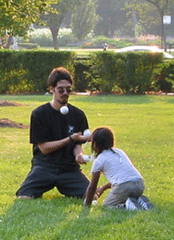I’ve been thinking of her face a lot recently.
Long black flowing hair. Deep, dark, penetrating eyes. Soft, warm hands part clenching, part caressing mine.
And it’s possible she was begging me to rape her.
Late at night along Khao San road - that famous backpackers’ haunt in Bangkok - as the parties begin to wind down, the prostitutes without a client for the night become more desperate. They follow you and beg. They grab your hands with both of theirs. Stare deep into your eyes, the desperation etched onto their young, beautiful faces – carrying echoes of pain far beyond their years.
I don’t know if she was a trafficking victim. I don’t know if beyond the façade of consent there was a story of brutality and violence and psychological manipulation, or whether it was just the daily bite of poverty. But I know for many of the girls, the daily rapes are preferred to returning to the pimp or mama-san without filling their quota, and so they hold your hands in theirs, and stare deep into your eyes and beg to be violated.
Behind each story of horror is a panoply of characters. The pimps lurking in the corner, negotiating the price, and arranging the meet-up. The girls often offered promises of love and comfort. As one ex-prostitute said, the pimps know to target the girls who “just want to be loved.” And then there are the clients, the Johns. Outsourcing violence to the pimps so they can carry out rape without being a rapist, so they can live out every fantasy and desire, while maintaining a mask of innocence, hidden behind a façade of consent, perhaps even charity for the impoverished girls they exploit.
I could’ve told this story not of Thailand but of almost any city or town in the U.S. The average age of entry into prostitution in the U.S. is 12 to 14. There are over 2,500 prostituted minors in NYC. They are over 100,000 prostituted minors in the US. They work on street corners. They’re advertised online and in newspapers. They’re sold by parents and friends and lovers and strangers. They’re sold in small residential towns and in fancy escort services. And they’re all hidden in plain sight. Impossible to find. Yet found constantly by Johns eager to find some soft, warm flesh. As International Justice Mission’s president, Gary Haugen, reflected: "It's the easiest kind of crime in the world to spot. Men look for it all day, every day."
Some girls are sold 40 times a night. The DOJ worked a case where a girl was sold 68 times in one night. You begin to do the math. 40 rapes a night. 5-6 nights a week. 200-240. For a month. 6000-7200. For a year. And the horror can seem almost too much to be true.
People sometimes ask me how I do this work. Frankly, I don’t know how you couldn’t. You stare into the eyes of someone stripped of their humanity and sold as meat, you see children dancing half-naked on stage to satiate the appetites of Western and local sex tourists. You meet a slave. How can you live with yourself if you don’t try to do something about it?
Today, March 8, is International Women’s Day. In Vanderbilt Hall, a coalition of NYU law school student groups will be fundraising for GEMS, and showing “Very Young Girls,” a documentary about prostitution of minors in NYC, about sex trafficking in NYC. It’s an important reminder of the horror and pain all around us, and the real people caught up in it. And it’s even more important to remember, to learn about the people fighting against it – person by person.
